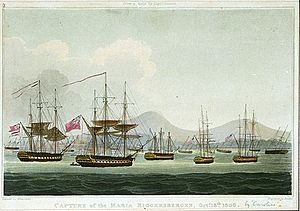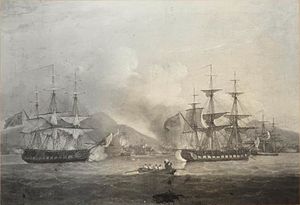Raid on Batavia (1806) facts for kids
Quick facts for kids Raid on Batavia |
|||||||
|---|---|---|---|---|---|---|---|
| Part of the Napoleonic Wars | |||||||
 A painting by Thomas Whitcombe depicting Batavia harbour in 1806. |
|||||||
|
|||||||
| Belligerents | |||||||
| Commanders and leaders | |||||||
| Strength | |||||||
| 4 ships of the line 2 frigates 1 brig |
1 frigate 8 smaller warships 22 merchant ships 1 gun battery |
||||||
| Casualties and losses | |||||||
| 1 killed 4 wounded |
1 frigate destroyed 7 smaller warships destroyed 20 merchant ships destroyed 1 brig captured 2 merchant ships captured |
||||||
The Raid on Batavia happened on November 27, 1806. It was a successful attack by the British navy. Their goal was to destroy Dutch warships near Java in the Dutch East Indies. These Dutch ships were a danger to British trade routes.
Admiral Edward Pellew led the British fleet. He had four large warships called ships of the line, two frigates (smaller, faster warships), and one brig (a small, two-masted ship). They sailed to Batavia (now Jakarta), the capital of Java.
Pellew expected to find many Dutch warships. However, the biggest Dutch ships had already left. They had sailed east to Griessie a month earlier. Pellew only found one frigate, the Phoenix, and some smaller warships. The Dutch crews drove their ships ashore to avoid fighting. The British then burned these wrecked ships. Pellew returned to his base, not knowing where the main Dutch fleet was.
This raid was part of a series of attacks. The British wanted to stop the Dutch from threatening their trade. Before this raid, British frigates had already captured two Dutch frigates. The raid made Batavia less useful as a Dutch naval base. But the main Dutch fleet was still at Griessie. So, Pellew led another attack the next year. Later, British forces took over the entire Dutch East Indies. This ended the war in that part of the world.
Why the Raid Happened
In 1806, a large French fleet left the Indian Ocean. This was good news for Admiral Pellew. It meant his small British fleet could now focus on the Dutch East Indies. His main target was the island of Java. This is where the main Dutch fleet and their base at Batavia were located.
The Kingdom of Holland (the Netherlands) was allied with France. Napoleon Bonaparte's brother, Louis Bonaparte, ruled it. Batavia was important because it was close to the Straits of Malacca. This strait was a key route for British trade with China. Dutch ships from Batavia could easily attack British merchant ships.
Pellew's trip was delayed by a rebellion in India. So, he sent frigates ahead to scout. In July, HMS Greyhound captured a Dutch convoy. Then, in October, HMS Caroline captured a Dutch frigate near Batavia. Just before this, the two largest Dutch ships, Pluto and Revolutie, had moved. They sailed to Griessie. The Dutch admiral, Hartsinck, wanted to spread out his ships. He hoped this would prevent them all from being destroyed.
Admiral Pellew left Madras in late 1806. He expected to fight the full Dutch fleet. His flagship was HMS Culloden, a powerful ship of the line. Other ships included HMS Powerful, HMS Russell, and HMS Belliqueux. He also had the frigate HMS Terpsichore, commanded by his son, Fleetwood Pellew. A small brig, HMS Seaflower, also joined them.
The Battle at Batavia

By November 23, Pellew's fleet was near the Sunda Strait. They met another British frigate, HMS Sir Francis Drake, which joined them. Three days later, they passed Bantam and captured a Dutch brig. They continued towards Batavia that night.
As they neared the port, the British ships split up. The frigates and brig took a shorter route. The larger ships of the line took a longer, deeper route. HMS Terpsichore surprised and captured a small Dutch warship called William. But Dutch lookouts spotted the main British fleet from a distance. They first thought it was a French fleet.
The Dutch officers, led by Captain Vander Sande, saw how many British ships there were. They decided it was useless to fight. The only warships left in the harbor were the Phoenix and six smaller armed ships. None of them could stand against the large British force. To stop the British, the Dutch captains drove all their ships ashore. About 22 merchant ships in the harbor did the same.
Admiral Pellew wanted to make sure the Dutch couldn't refloat their ships. He ordered landing parties to gather in boats. These boats were covered by fire from the British frigates. Fleetwood Pellew led the boats towards the Phoenix. They came under fire from the grounded ships and shore batteries. Pellew's men boarded the Phoenix. They found the Dutch crew had just left the ship, sinking it as they went.
Even though the Phoenix was now useless, its guns were turned on the other beached ships. This helped cover the British boats. The British spread out to board and burn the other Dutch ships. They destroyed 20 grounded merchant ships. Two other merchant ships were captured. Before leaving, Captain Pellew set fire to the Phoenix, burning it completely. The whole operation happened under heavy fire from the shore. But the British had only one soldier killed and three men wounded.
Admiral Pellew did not have enough troops to attack Batavia itself. So, he left the harbor. He prepared the captured ships to return to Madras. He sent all Dutch prisoners back to shore. The captured William was in very bad shape. Admiral Pellew ordered it to be burned. Pellew then ordered his fleet to separate. HMS Culloden sailed to Malacca.
What Happened Next
The British raid on Batavia destroyed 28 Dutch ships. Besides the Phoenix, the British burned two 18-gun brigs, a 14-gun ship, a 10-gun ship, an 8-gun ship, and a 6-gun ship. Only three ships were captured: two merchant vessels and the Maria Wilhelmina.
Destroying these smaller Dutch ships was a big win for Pellew. Only the older, larger Dutch ships of the line were left. These ships were not in good condition. They posed little threat to British trade. Still, Pellew returned to the Java Sea in 1807. He found and destroyed the remaining Dutch warships at the Raid on Griessie. This happened a year after the success at Batavia.
The British didn't have enough resources for a bigger attack on the East Indies right away. Also, French bases in the Indian Ocean were still a threat. But by 1810, British forces were strong enough. They launched a series of invasions. These quickly removed the last Dutch presence in the Pacific.

